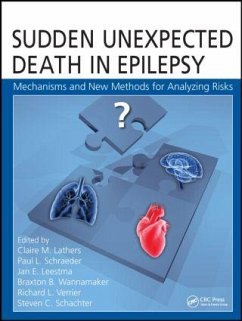Sudden Unexpected Death in Epilepsy
Mechanisms and New Methods for Analyzing Risks
Herausgeber: Lathers, Claire M; Schachter, Md; Verrier, F a C C; Wannamaker, Braxton B; Leestma, Jan E; Schraeder, Paul L
Sudden Unexpected Death in Epilepsy
Mechanisms and New Methods for Analyzing Risks
Herausgeber: Lathers, Claire M; Schachter, Md; Verrier, F a C C; Wannamaker, Braxton B; Leestma, Jan E; Schraeder, Paul L
- Gebundenes Buch
- Merkliste
- Auf die Merkliste
- Bewerten Bewerten
- Teilen
- Produkt teilen
- Produkterinnerung
- Produkterinnerung
This book builds on earlier works focusing on the clinical problem of sudden unexpected death in epilepsy (SUDEP). Developed over the last two years, the SUDEP Classification System and Risk Factor Cluster ID method will help to address gaps in knowledge about the causes and possible prevention of this tragic complication. The book includes case studies of SUDEP and discusses how physicians can identify individuals at risk for SUDEP and possibly lessen the chance of occurrence. It also describes related clinical and animal studies needed to classify risk factors for SUDEP victims.
Andere Kunden interessierten sich auch für
![Forensic Neuropathology Forensic Neuropathology]() Jan E LeestmaForensic Neuropathology258,99 €
Jan E LeestmaForensic Neuropathology258,99 €![Sex-Related Homicide and Death Investigation Sex-Related Homicide and Death Investigation]() Vernon J GeberthSex-Related Homicide and Death Investigation212,99 €
Vernon J GeberthSex-Related Homicide and Death Investigation212,99 €![Investigative Forensic Hypnosis Investigative Forensic Hypnosis]() Joe NiehausInvestigative Forensic Hypnosis206,99 €
Joe NiehausInvestigative Forensic Hypnosis206,99 €![Forensic Mental Health Forensic Mental Health]() Mary McmurranForensic Mental Health202,99 €
Mary McmurranForensic Mental Health202,99 €![Autoerotic Deaths Autoerotic Deaths]() Anny SauvageauAutoerotic Deaths202,99 €
Anny SauvageauAutoerotic Deaths202,99 €![Forensic Anthropology Forensic Anthropology]() Natalie R LangleyForensic Anthropology136,99 €
Natalie R LangleyForensic Anthropology136,99 €![Biological Influences on Criminal Behavior Biological Influences on Criminal Behavior]() Gail AndersonBiological Influences on Criminal Behavior159,99 €
Gail AndersonBiological Influences on Criminal Behavior159,99 €-
-
-
This book builds on earlier works focusing on the clinical problem of sudden unexpected death in epilepsy (SUDEP). Developed over the last two years, the SUDEP Classification System and Risk Factor Cluster ID method will help to address gaps in knowledge about the causes and possible prevention of this tragic complication. The book includes case studies of SUDEP and discusses how physicians can identify individuals at risk for SUDEP and possibly lessen the chance of occurrence. It also describes related clinical and animal studies needed to classify risk factors for SUDEP victims.
Hinweis: Dieser Artikel kann nur an eine deutsche Lieferadresse ausgeliefert werden.
Hinweis: Dieser Artikel kann nur an eine deutsche Lieferadresse ausgeliefert werden.
Produktdetails
- Produktdetails
- Verlag: Taylor & Francis
- Seitenzahl: 350
- Erscheinungstermin: 1. März 2015
- Englisch
- Abmessung: 277mm x 213mm x 25mm
- Gewicht: 1021g
- ISBN-13: 9781482223859
- ISBN-10: 1482223856
- Artikelnr.: 41368787
- Herstellerkennzeichnung
- Libri GmbH
- Europaallee 1
- 36244 Bad Hersfeld
- gpsr@libri.de
- Verlag: Taylor & Francis
- Seitenzahl: 350
- Erscheinungstermin: 1. März 2015
- Englisch
- Abmessung: 277mm x 213mm x 25mm
- Gewicht: 1021g
- ISBN-13: 9781482223859
- ISBN-10: 1482223856
- Artikelnr.: 41368787
- Herstellerkennzeichnung
- Libri GmbH
- Europaallee 1
- 36244 Bad Hersfeld
- gpsr@libri.de
Claire M. Lathers, PhD, FCP, has been credentialed as a senior biomedical research scientist by the FDA for international recognition of her work in the two areas of cardiovascular autonomic dysfunction associated with sudden death in persons with epilepsy and with space flight and for her professional management experience in drug development, the business world, and clinical pharmacology. The primary focus of her international cardiovascular pharmacology research career has centered on autonomic peripheral and central mechanisms involved in the control and regulation of blood pressure, heart rate and rhythm, and electroencephalogram. Dr. Lathers served as President Clinton's lead person on the Food Safety Program at FDA, was Director of the Office of New Animal Drug Evaluation and a Senior Advisor for Science at FDA. Paul L. Schraeder, MD, FAAN, is Professor Emeritus of Neurology at Drexel University College of Medicine. Along with Dr. Lathers, Dr. Schraeder has spent over three decades studying and investigating the mystery of SUDEP and developed the first experimental animal models of this fatal phenomenon. Dr. Schraeder organized a collaborative nationwide survey of how coroners and medical examiners evaluate the deaths of persons with a history of epilepsy. Jan E. Leestma, MD, MBA, is licensed as a physician in the states of Illinois and Michigan and certified by the American Board of Pathology in both Anatomic Pathology and Neuropathology. His areas of expertise and publication history include sudden unexpected death in epilepsy, viral infections of the central nervous system, and forensic neuropathology. Braxton B. Wannamaker, MD, FAAN is Clinical Professor of Neurology at the Medical University of South Carolina (MUSC). In his long career devoted to comprehensive care of persons with epilepsy, Dr. Wannamaker has served as a member of the NINDS Epilepsy Advisory Committee, as a board member of the Epilepsy Foundation of America, and as president of the American Epilepsy Society. Richard L. Verrier, PhD, FACC, is Associate Professor of Medicine, Harvard Medical School, Beth Israel Deaconess Medical Center, Boston, Massachusetts. He has investigated autonomic factors in sudden cardiac death for over 25 years in both clinical and experimental studies. He demonstrated that the phenomenon of T-wave alternans (TWA) is strongly correlated with ventricular fibrillation, the arrhythmia responsible for sudden cardiac death in patients with cardiovascular disease. Steven C. Schachter, MD, is Professor of Neurology at Harvard Medical School; chief academic officer and director of neurotechnology for the Consortia for Improving Medicine Through Innovation and Technology in Boston, Massachusetts; and senior neurologist at Beth Israel Deaconess Medical Center, Boston. He has directed over 70 research projects involving antiepileptic therapies and published over 200 articles and chapters. He compiled the six-volume Brainstorms series, and edited or wrote 23 other books on epilepsy and behavior.
Forensics of SUDEP and Cluster Risk Factor Identification. Mechanistic
Mystery: Risk Factors in SUDEP. SUDEP: A Syndrome with Several If Not Many
Potential Underlying Mechanisms. Unravel the Global Mystery of SUDEP.
Decision Analysis and Classification Methods for SUDEP Risk Factor
Identification. Forensic SUDEP Cluster Risk Factor Identifier Method.
Forensic Cases Classified as SUDEP Cluster Risk Factor Identifiers. How to
and How Not to Use Cluster ID Method. Clinical Cases Classified as SUDEP
Cluster Risk Factor Identifiers. SUDEP: Continued Forensic Challenges. A
South Carolina Cohort of Epilepsy Patients. Measuring the Incidence of
SUDEP Using Forensic and National Data. Risk Predictor: Individual SUDEP
Risk Factor Cluster IDs. Intracranial Pressure, Cerebral Edema, and
Obstructive Sleep Apnea: A Risk Factor Cluster for SUDEP? Neurocardiac
Interactions in Sudden Unexpected Death in Epilepsy: Can Ambulatory
Electrocardiogram-Based Assessment of Autonomic Function and T-Wave
Alternans. Help to Evaluate Risk? Patient Management Using Cluster Risk
Factor Identifiers. Future Clinical and Animal Studies. Animal Model
Cluster IDs: Mechanisms and Risk Factors for SUDEP. SUDEP Animal Models:
Mechanisms of Risks.Sudden Death Animal Models to Study Nervous System
Sites of Action for Disease and Pharmacological Intervention. A
Characterization of the Lockstep Phenomenon in Phenobarbital-Pretreated
Cats. Relationship of the Lockstep Phenomenon and Precipitous Changes in
Blood Pressure. Interspike Interval Histogram Characterization of
Synchronized Cardiac Sympathetic Neural Discharge and Epileptogenic
Activity in the Electrocorticogram of the Cat. SUDEP Risk Mechanisms:
Animal Models and Clinical Studies. Abnormal Brain Activity Triggers
Long-Term Potentiation in Sympathetic Ganglia: Implication for Sudden
Death. ß1-Adrenergic Blockade Prevents Cardiac Dysfunction and Increased
Susceptibility to Experimental Arrhythmias Following Status Epilepticus in
Rats. Cardiac Myocyte Damage, Electrocardiographic Dysfunction, and Ion
Channel Remodeling in Rodent Models of Seizure Disorders. A Rat Model for
Exploring the Contributions of Ventricular Arrhythmias to Sudden Death in
Epilepsy. Neurotransmitters Implicated in Control of Sudden Unexpected
Death in Epilepsy in Animal Models. n-3 Fatty Acids and Sudden Unexpected
Death in Epilepsy: A Translational Approach. Sudden Death in Epilepsy:
Relationship to the Sleep-Wake Circadian Cycle and Fractal Physiology.
Lockstep in Humans: Bridging the Gap. Postictal Generalized EEG Suppression
and Sudden Unexpected Death in Epilepsy. Mechanisms of SUDEP: Lessons from
Cases Occurring in the Epilepsy Monitoring Unit. Compliance with
Antiepileptic Drug Treatment and the Risk of SUDEP. Providing Information
about SUDEP: The Benefits and Challenges. Mechanistic SUDEP Risk Factor
Studies for Animals and Humans. Index.
Mystery: Risk Factors in SUDEP. SUDEP: A Syndrome with Several If Not Many
Potential Underlying Mechanisms. Unravel the Global Mystery of SUDEP.
Decision Analysis and Classification Methods for SUDEP Risk Factor
Identification. Forensic SUDEP Cluster Risk Factor Identifier Method.
Forensic Cases Classified as SUDEP Cluster Risk Factor Identifiers. How to
and How Not to Use Cluster ID Method. Clinical Cases Classified as SUDEP
Cluster Risk Factor Identifiers. SUDEP: Continued Forensic Challenges. A
South Carolina Cohort of Epilepsy Patients. Measuring the Incidence of
SUDEP Using Forensic and National Data. Risk Predictor: Individual SUDEP
Risk Factor Cluster IDs. Intracranial Pressure, Cerebral Edema, and
Obstructive Sleep Apnea: A Risk Factor Cluster for SUDEP? Neurocardiac
Interactions in Sudden Unexpected Death in Epilepsy: Can Ambulatory
Electrocardiogram-Based Assessment of Autonomic Function and T-Wave
Alternans. Help to Evaluate Risk? Patient Management Using Cluster Risk
Factor Identifiers. Future Clinical and Animal Studies. Animal Model
Cluster IDs: Mechanisms and Risk Factors for SUDEP. SUDEP Animal Models:
Mechanisms of Risks.Sudden Death Animal Models to Study Nervous System
Sites of Action for Disease and Pharmacological Intervention. A
Characterization of the Lockstep Phenomenon in Phenobarbital-Pretreated
Cats. Relationship of the Lockstep Phenomenon and Precipitous Changes in
Blood Pressure. Interspike Interval Histogram Characterization of
Synchronized Cardiac Sympathetic Neural Discharge and Epileptogenic
Activity in the Electrocorticogram of the Cat. SUDEP Risk Mechanisms:
Animal Models and Clinical Studies. Abnormal Brain Activity Triggers
Long-Term Potentiation in Sympathetic Ganglia: Implication for Sudden
Death. ß1-Adrenergic Blockade Prevents Cardiac Dysfunction and Increased
Susceptibility to Experimental Arrhythmias Following Status Epilepticus in
Rats. Cardiac Myocyte Damage, Electrocardiographic Dysfunction, and Ion
Channel Remodeling in Rodent Models of Seizure Disorders. A Rat Model for
Exploring the Contributions of Ventricular Arrhythmias to Sudden Death in
Epilepsy. Neurotransmitters Implicated in Control of Sudden Unexpected
Death in Epilepsy in Animal Models. n-3 Fatty Acids and Sudden Unexpected
Death in Epilepsy: A Translational Approach. Sudden Death in Epilepsy:
Relationship to the Sleep-Wake Circadian Cycle and Fractal Physiology.
Lockstep in Humans: Bridging the Gap. Postictal Generalized EEG Suppression
and Sudden Unexpected Death in Epilepsy. Mechanisms of SUDEP: Lessons from
Cases Occurring in the Epilepsy Monitoring Unit. Compliance with
Antiepileptic Drug Treatment and the Risk of SUDEP. Providing Information
about SUDEP: The Benefits and Challenges. Mechanistic SUDEP Risk Factor
Studies for Animals and Humans. Index.
Forensics of SUDEP and Cluster Risk Factor Identification. Mechanistic
Mystery: Risk Factors in SUDEP. SUDEP: A Syndrome with Several If Not Many
Potential Underlying Mechanisms. Unravel the Global Mystery of SUDEP.
Decision Analysis and Classification Methods for SUDEP Risk Factor
Identification. Forensic SUDEP Cluster Risk Factor Identifier Method.
Forensic Cases Classified as SUDEP Cluster Risk Factor Identifiers. How to
and How Not to Use Cluster ID Method. Clinical Cases Classified as SUDEP
Cluster Risk Factor Identifiers. SUDEP: Continued Forensic Challenges. A
South Carolina Cohort of Epilepsy Patients. Measuring the Incidence of
SUDEP Using Forensic and National Data. Risk Predictor: Individual SUDEP
Risk Factor Cluster IDs. Intracranial Pressure, Cerebral Edema, and
Obstructive Sleep Apnea: A Risk Factor Cluster for SUDEP? Neurocardiac
Interactions in Sudden Unexpected Death in Epilepsy: Can Ambulatory
Electrocardiogram-Based Assessment of Autonomic Function and T-Wave
Alternans. Help to Evaluate Risk? Patient Management Using Cluster Risk
Factor Identifiers. Future Clinical and Animal Studies. Animal Model
Cluster IDs: Mechanisms and Risk Factors for SUDEP. SUDEP Animal Models:
Mechanisms of Risks.Sudden Death Animal Models to Study Nervous System
Sites of Action for Disease and Pharmacological Intervention. A
Characterization of the Lockstep Phenomenon in Phenobarbital-Pretreated
Cats. Relationship of the Lockstep Phenomenon and Precipitous Changes in
Blood Pressure. Interspike Interval Histogram Characterization of
Synchronized Cardiac Sympathetic Neural Discharge and Epileptogenic
Activity in the Electrocorticogram of the Cat. SUDEP Risk Mechanisms:
Animal Models and Clinical Studies. Abnormal Brain Activity Triggers
Long-Term Potentiation in Sympathetic Ganglia: Implication for Sudden
Death. ß1-Adrenergic Blockade Prevents Cardiac Dysfunction and Increased
Susceptibility to Experimental Arrhythmias Following Status Epilepticus in
Rats. Cardiac Myocyte Damage, Electrocardiographic Dysfunction, and Ion
Channel Remodeling in Rodent Models of Seizure Disorders. A Rat Model for
Exploring the Contributions of Ventricular Arrhythmias to Sudden Death in
Epilepsy. Neurotransmitters Implicated in Control of Sudden Unexpected
Death in Epilepsy in Animal Models. n-3 Fatty Acids and Sudden Unexpected
Death in Epilepsy: A Translational Approach. Sudden Death in Epilepsy:
Relationship to the Sleep-Wake Circadian Cycle and Fractal Physiology.
Lockstep in Humans: Bridging the Gap. Postictal Generalized EEG Suppression
and Sudden Unexpected Death in Epilepsy. Mechanisms of SUDEP: Lessons from
Cases Occurring in the Epilepsy Monitoring Unit. Compliance with
Antiepileptic Drug Treatment and the Risk of SUDEP. Providing Information
about SUDEP: The Benefits and Challenges. Mechanistic SUDEP Risk Factor
Studies for Animals and Humans. Index.
Mystery: Risk Factors in SUDEP. SUDEP: A Syndrome with Several If Not Many
Potential Underlying Mechanisms. Unravel the Global Mystery of SUDEP.
Decision Analysis and Classification Methods for SUDEP Risk Factor
Identification. Forensic SUDEP Cluster Risk Factor Identifier Method.
Forensic Cases Classified as SUDEP Cluster Risk Factor Identifiers. How to
and How Not to Use Cluster ID Method. Clinical Cases Classified as SUDEP
Cluster Risk Factor Identifiers. SUDEP: Continued Forensic Challenges. A
South Carolina Cohort of Epilepsy Patients. Measuring the Incidence of
SUDEP Using Forensic and National Data. Risk Predictor: Individual SUDEP
Risk Factor Cluster IDs. Intracranial Pressure, Cerebral Edema, and
Obstructive Sleep Apnea: A Risk Factor Cluster for SUDEP? Neurocardiac
Interactions in Sudden Unexpected Death in Epilepsy: Can Ambulatory
Electrocardiogram-Based Assessment of Autonomic Function and T-Wave
Alternans. Help to Evaluate Risk? Patient Management Using Cluster Risk
Factor Identifiers. Future Clinical and Animal Studies. Animal Model
Cluster IDs: Mechanisms and Risk Factors for SUDEP. SUDEP Animal Models:
Mechanisms of Risks.Sudden Death Animal Models to Study Nervous System
Sites of Action for Disease and Pharmacological Intervention. A
Characterization of the Lockstep Phenomenon in Phenobarbital-Pretreated
Cats. Relationship of the Lockstep Phenomenon and Precipitous Changes in
Blood Pressure. Interspike Interval Histogram Characterization of
Synchronized Cardiac Sympathetic Neural Discharge and Epileptogenic
Activity in the Electrocorticogram of the Cat. SUDEP Risk Mechanisms:
Animal Models and Clinical Studies. Abnormal Brain Activity Triggers
Long-Term Potentiation in Sympathetic Ganglia: Implication for Sudden
Death. ß1-Adrenergic Blockade Prevents Cardiac Dysfunction and Increased
Susceptibility to Experimental Arrhythmias Following Status Epilepticus in
Rats. Cardiac Myocyte Damage, Electrocardiographic Dysfunction, and Ion
Channel Remodeling in Rodent Models of Seizure Disorders. A Rat Model for
Exploring the Contributions of Ventricular Arrhythmias to Sudden Death in
Epilepsy. Neurotransmitters Implicated in Control of Sudden Unexpected
Death in Epilepsy in Animal Models. n-3 Fatty Acids and Sudden Unexpected
Death in Epilepsy: A Translational Approach. Sudden Death in Epilepsy:
Relationship to the Sleep-Wake Circadian Cycle and Fractal Physiology.
Lockstep in Humans: Bridging the Gap. Postictal Generalized EEG Suppression
and Sudden Unexpected Death in Epilepsy. Mechanisms of SUDEP: Lessons from
Cases Occurring in the Epilepsy Monitoring Unit. Compliance with
Antiepileptic Drug Treatment and the Risk of SUDEP. Providing Information
about SUDEP: The Benefits and Challenges. Mechanistic SUDEP Risk Factor
Studies for Animals and Humans. Index.








